Financial Performance Management Report: Morrison plc Analysis
VerifiedAdded on 2023/01/05
|13
|3436
|68
Report
AI Summary
This report delves into financial performance management, focusing on environmental accounting and its impact on business decisions. The report is divided into two parts, the first part explores environmental accounting, including prevention, appraisal, and failure costs, along with cost-benefit analysis and techniques for identifying and managing these costs such as input/output analysis, flow cost accounting, and activity-based costing. The second part discusses decision-making processes, planning tools, and management accounting techniques to solve financial issues, with specific examples related to Morrison plc. It highlights the importance of key performance indicators (KPIs) and their role in improving financial performance. The report covers how environmental costs are recorded and controlled, and provides insights into financial reporting and how businesses can effectively manage their financial resources.
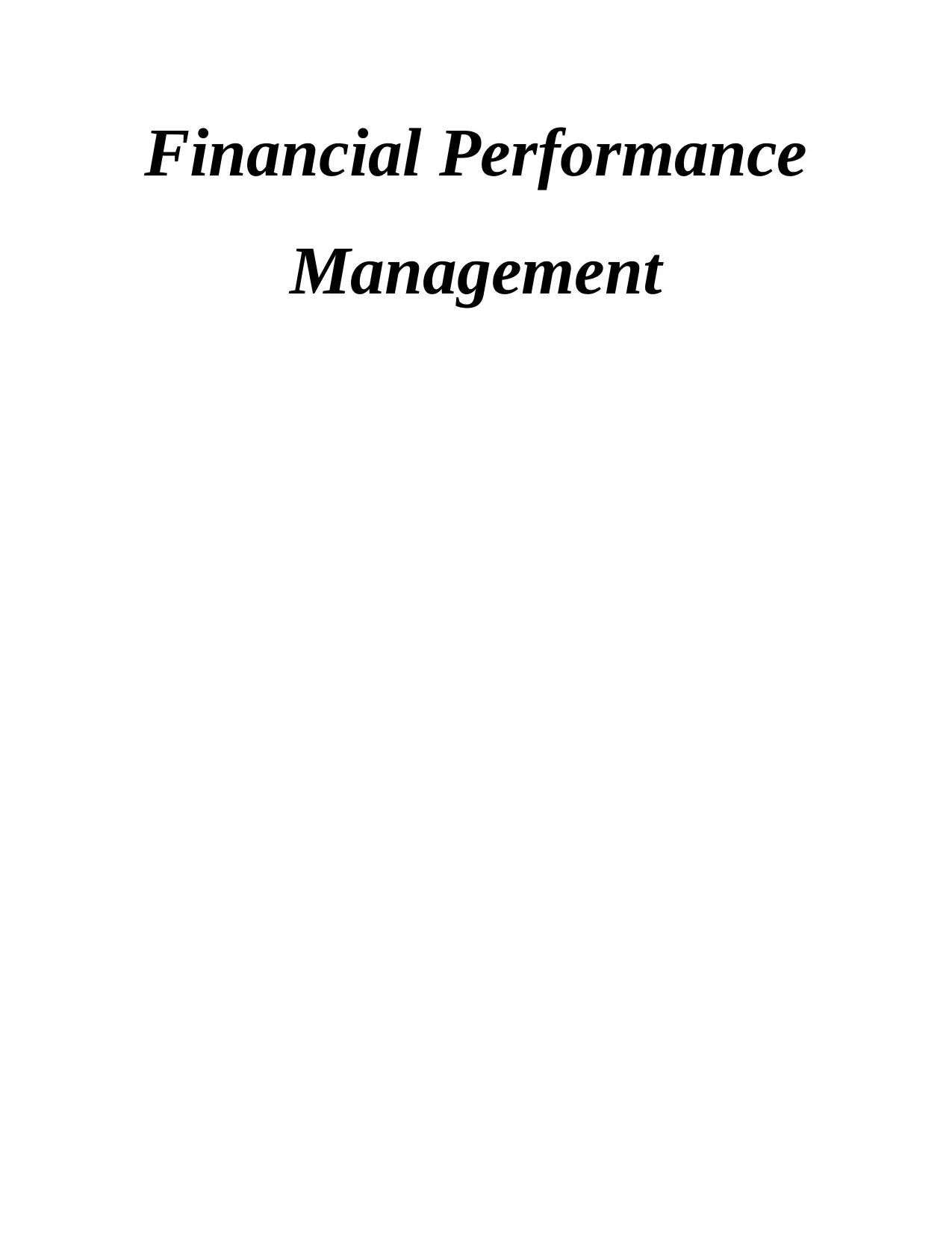
Financial Performance
Management
Management
Paraphrase This Document
Need a fresh take? Get an instant paraphrase of this document with our AI Paraphraser
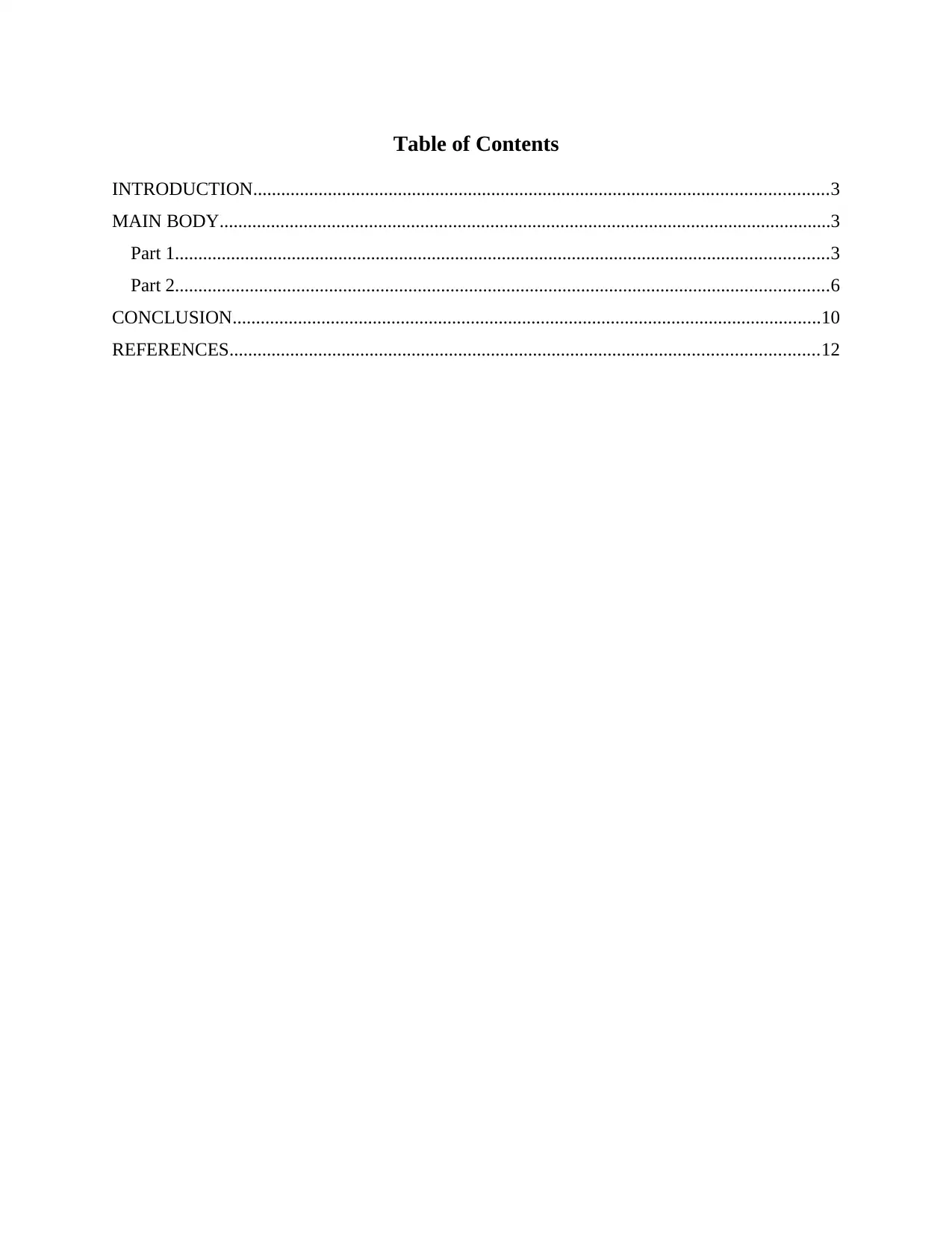
Table of Contents
INTRODUCTION...........................................................................................................................3
MAIN BODY...................................................................................................................................3
Part 1............................................................................................................................................3
Part 2............................................................................................................................................6
CONCLUSION..............................................................................................................................10
REFERENCES..............................................................................................................................12
INTRODUCTION...........................................................................................................................3
MAIN BODY...................................................................................................................................3
Part 1............................................................................................................................................3
Part 2............................................................................................................................................6
CONCLUSION..............................................................................................................................10
REFERENCES..............................................................................................................................12
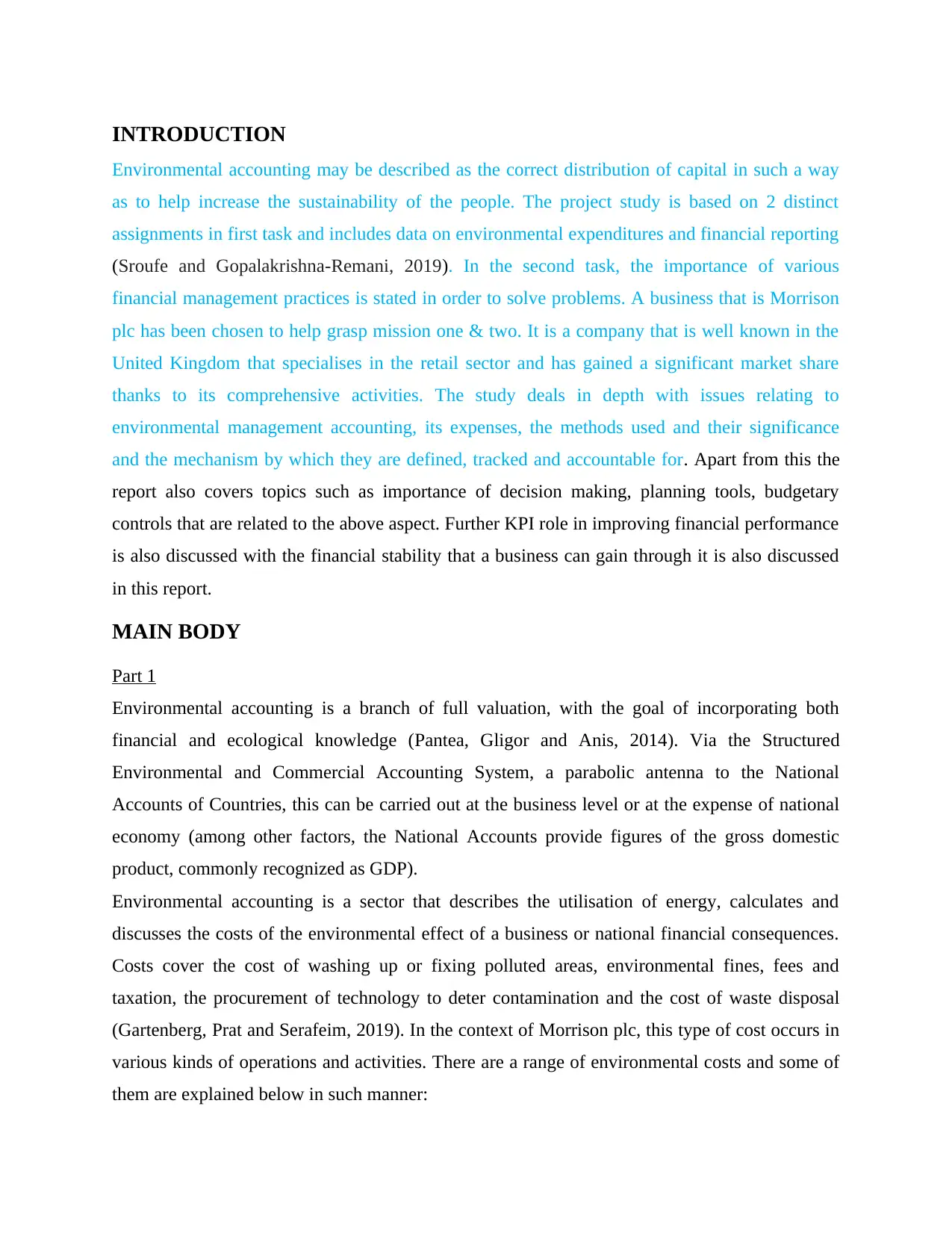
INTRODUCTION
Environmental accounting may be described as the correct distribution of capital in such a way
as to help increase the sustainability of the people. The project study is based on 2 distinct
assignments in first task and includes data on environmental expenditures and financial reporting
(Sroufe and Gopalakrishna-Remani, 2019). In the second task, the importance of various
financial management practices is stated in order to solve problems. A business that is Morrison
plc has been chosen to help grasp mission one & two. It is a company that is well known in the
United Kingdom that specialises in the retail sector and has gained a significant market share
thanks to its comprehensive activities. The study deals in depth with issues relating to
environmental management accounting, its expenses, the methods used and their significance
and the mechanism by which they are defined, tracked and accountable for. Apart from this the
report also covers topics such as importance of decision making, planning tools, budgetary
controls that are related to the above aspect. Further KPI role in improving financial performance
is also discussed with the financial stability that a business can gain through it is also discussed
in this report.
MAIN BODY
Part 1
Environmental accounting is a branch of full valuation, with the goal of incorporating both
financial and ecological knowledge (Pantea, Gligor and Anis, 2014). Via the Structured
Environmental and Commercial Accounting System, a parabolic antenna to the National
Accounts of Countries, this can be carried out at the business level or at the expense of national
economy (among other factors, the National Accounts provide figures of the gross domestic
product, commonly recognized as GDP).
Environmental accounting is a sector that describes the utilisation of energy, calculates and
discusses the costs of the environmental effect of a business or national financial consequences.
Costs cover the cost of washing up or fixing polluted areas, environmental fines, fees and
taxation, the procurement of technology to deter contamination and the cost of waste disposal
(Gartenberg, Prat and Serafeim, 2019). In the context of Morrison plc, this type of cost occurs in
various kinds of operations and activities. There are a range of environmental costs and some of
them are explained below in such manner:
Environmental accounting may be described as the correct distribution of capital in such a way
as to help increase the sustainability of the people. The project study is based on 2 distinct
assignments in first task and includes data on environmental expenditures and financial reporting
(Sroufe and Gopalakrishna-Remani, 2019). In the second task, the importance of various
financial management practices is stated in order to solve problems. A business that is Morrison
plc has been chosen to help grasp mission one & two. It is a company that is well known in the
United Kingdom that specialises in the retail sector and has gained a significant market share
thanks to its comprehensive activities. The study deals in depth with issues relating to
environmental management accounting, its expenses, the methods used and their significance
and the mechanism by which they are defined, tracked and accountable for. Apart from this the
report also covers topics such as importance of decision making, planning tools, budgetary
controls that are related to the above aspect. Further KPI role in improving financial performance
is also discussed with the financial stability that a business can gain through it is also discussed
in this report.
MAIN BODY
Part 1
Environmental accounting is a branch of full valuation, with the goal of incorporating both
financial and ecological knowledge (Pantea, Gligor and Anis, 2014). Via the Structured
Environmental and Commercial Accounting System, a parabolic antenna to the National
Accounts of Countries, this can be carried out at the business level or at the expense of national
economy (among other factors, the National Accounts provide figures of the gross domestic
product, commonly recognized as GDP).
Environmental accounting is a sector that describes the utilisation of energy, calculates and
discusses the costs of the environmental effect of a business or national financial consequences.
Costs cover the cost of washing up or fixing polluted areas, environmental fines, fees and
taxation, the procurement of technology to deter contamination and the cost of waste disposal
(Gartenberg, Prat and Serafeim, 2019). In the context of Morrison plc, this type of cost occurs in
various kinds of operations and activities. There are a range of environmental costs and some of
them are explained below in such manner:
⊘ This is a preview!⊘
Do you want full access?
Subscribe today to unlock all pages.

Trusted by 1+ million students worldwide
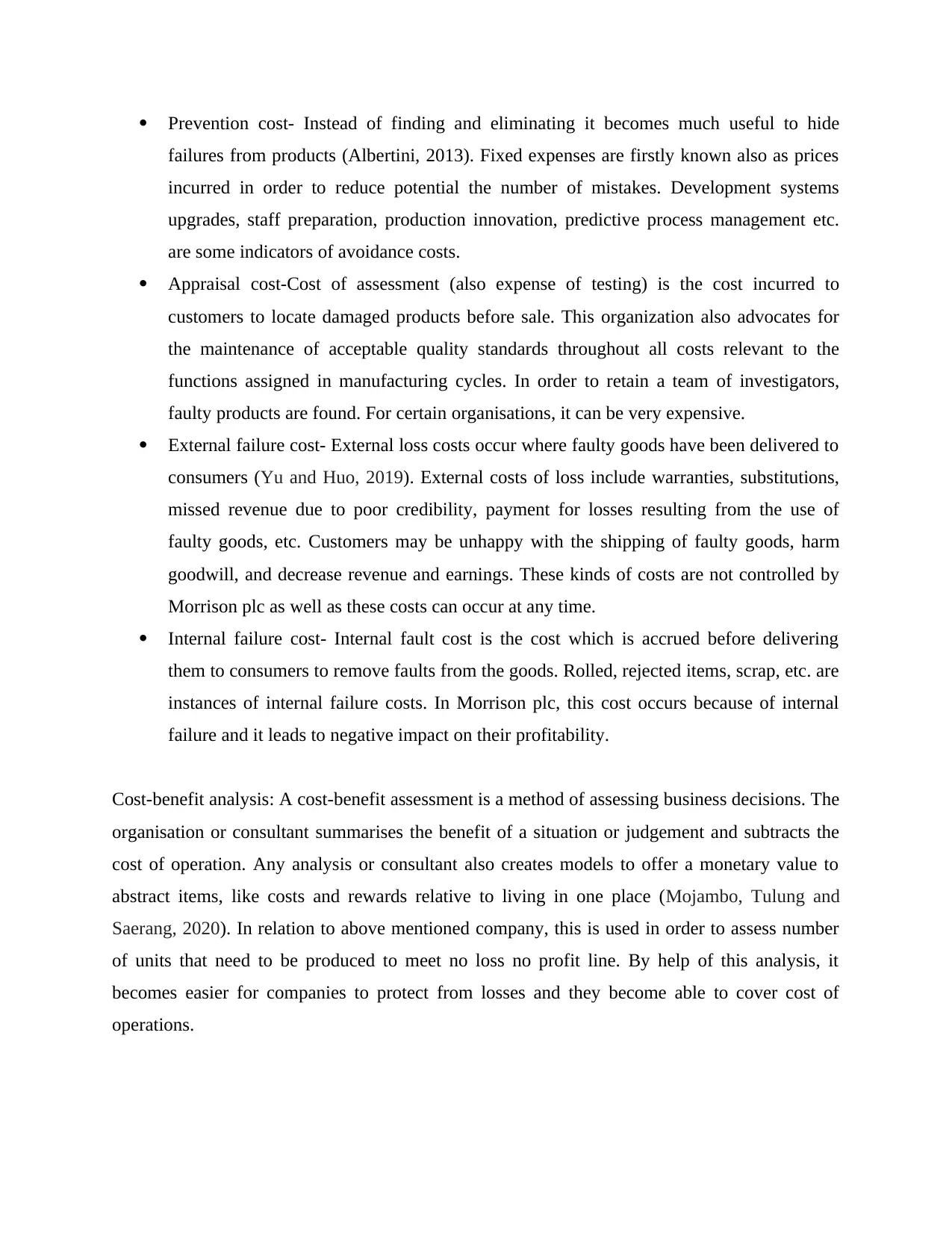
Prevention cost- Instead of finding and eliminating it becomes much useful to hide
failures from products (Albertini, 2013). Fixed expenses are firstly known also as prices
incurred in order to reduce potential the number of mistakes. Development systems
upgrades, staff preparation, production innovation, predictive process management etc.
are some indicators of avoidance costs.
Appraisal cost-Cost of assessment (also expense of testing) is the cost incurred to
customers to locate damaged products before sale. This organization also advocates for
the maintenance of acceptable quality standards throughout all costs relevant to the
functions assigned in manufacturing cycles. In order to retain a team of investigators,
faulty products are found. For certain organisations, it can be very expensive.
External failure cost- External loss costs occur where faulty goods have been delivered to
consumers (Yu and Huo, 2019). External costs of loss include warranties, substitutions,
missed revenue due to poor credibility, payment for losses resulting from the use of
faulty goods, etc. Customers may be unhappy with the shipping of faulty goods, harm
goodwill, and decrease revenue and earnings. These kinds of costs are not controlled by
Morrison plc as well as these costs can occur at any time.
Internal failure cost- Internal fault cost is the cost which is accrued before delivering
them to consumers to remove faults from the goods. Rolled, rejected items, scrap, etc. are
instances of internal failure costs. In Morrison plc, this cost occurs because of internal
failure and it leads to negative impact on their profitability.
Cost-benefit analysis: A cost-benefit assessment is a method of assessing business decisions. The
organisation or consultant summarises the benefit of a situation or judgement and subtracts the
cost of operation. Any analysis or consultant also creates models to offer a monetary value to
abstract items, like costs and rewards relative to living in one place (Mojambo, Tulung and
Saerang, 2020). In relation to above mentioned company, this is used in order to assess number
of units that need to be produced to meet no loss no profit line. By help of this analysis, it
becomes easier for companies to protect from losses and they become able to cover cost of
operations.
failures from products (Albertini, 2013). Fixed expenses are firstly known also as prices
incurred in order to reduce potential the number of mistakes. Development systems
upgrades, staff preparation, production innovation, predictive process management etc.
are some indicators of avoidance costs.
Appraisal cost-Cost of assessment (also expense of testing) is the cost incurred to
customers to locate damaged products before sale. This organization also advocates for
the maintenance of acceptable quality standards throughout all costs relevant to the
functions assigned in manufacturing cycles. In order to retain a team of investigators,
faulty products are found. For certain organisations, it can be very expensive.
External failure cost- External loss costs occur where faulty goods have been delivered to
consumers (Yu and Huo, 2019). External costs of loss include warranties, substitutions,
missed revenue due to poor credibility, payment for losses resulting from the use of
faulty goods, etc. Customers may be unhappy with the shipping of faulty goods, harm
goodwill, and decrease revenue and earnings. These kinds of costs are not controlled by
Morrison plc as well as these costs can occur at any time.
Internal failure cost- Internal fault cost is the cost which is accrued before delivering
them to consumers to remove faults from the goods. Rolled, rejected items, scrap, etc. are
instances of internal failure costs. In Morrison plc, this cost occurs because of internal
failure and it leads to negative impact on their profitability.
Cost-benefit analysis: A cost-benefit assessment is a method of assessing business decisions. The
organisation or consultant summarises the benefit of a situation or judgement and subtracts the
cost of operation. Any analysis or consultant also creates models to offer a monetary value to
abstract items, like costs and rewards relative to living in one place (Mojambo, Tulung and
Saerang, 2020). In relation to above mentioned company, this is used in order to assess number
of units that need to be produced to meet no loss no profit line. By help of this analysis, it
becomes easier for companies to protect from losses and they become able to cover cost of
operations.
Paraphrase This Document
Need a fresh take? Get an instant paraphrase of this document with our AI Paraphraser
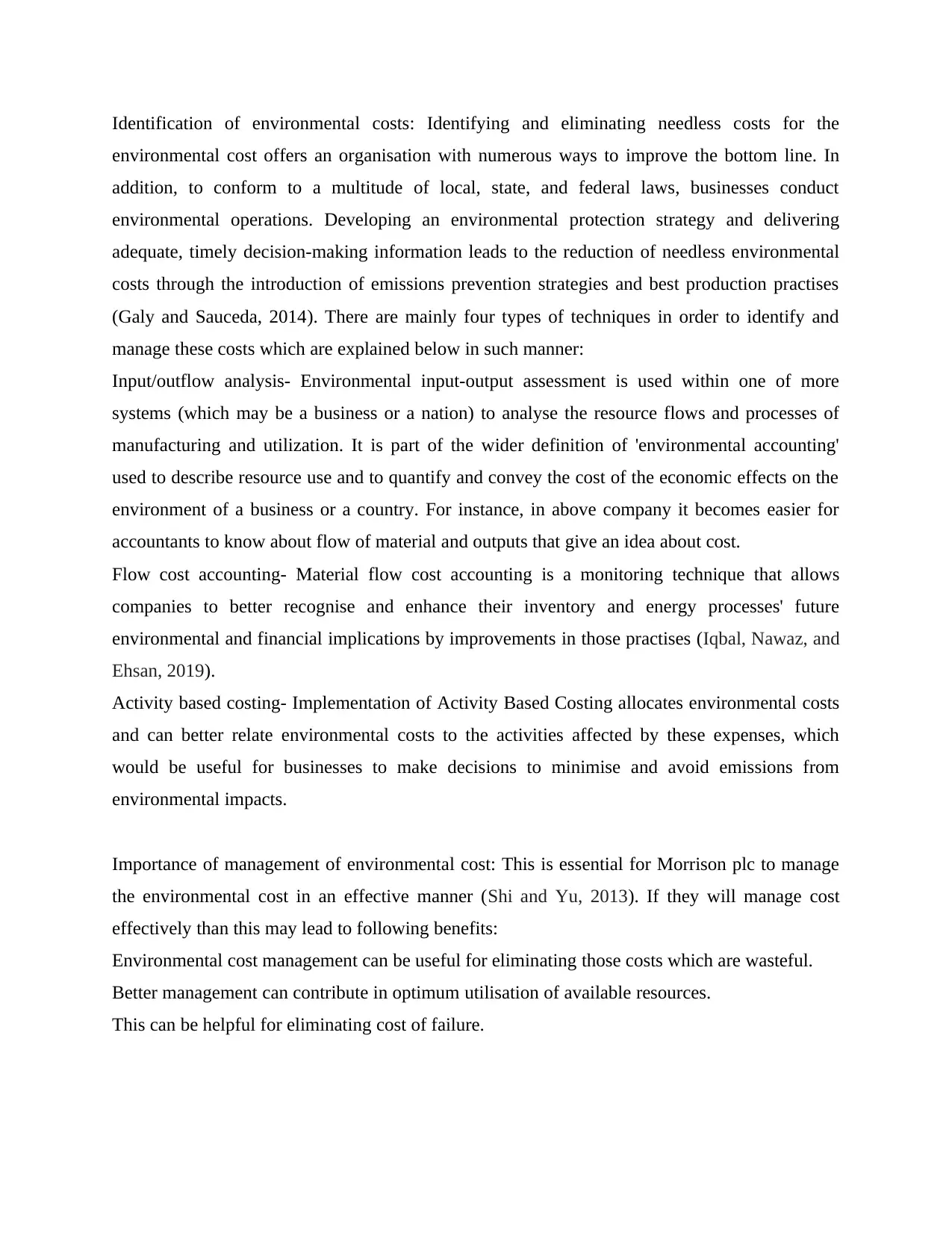
Identification of environmental costs: Identifying and eliminating needless costs for the
environmental cost offers an organisation with numerous ways to improve the bottom line. In
addition, to conform to a multitude of local, state, and federal laws, businesses conduct
environmental operations. Developing an environmental protection strategy and delivering
adequate, timely decision-making information leads to the reduction of needless environmental
costs through the introduction of emissions prevention strategies and best production practises
(Galy and Sauceda, 2014). There are mainly four types of techniques in order to identify and
manage these costs which are explained below in such manner:
Input/outflow analysis- Environmental input-output assessment is used within one of more
systems (which may be a business or a nation) to analyse the resource flows and processes of
manufacturing and utilization. It is part of the wider definition of 'environmental accounting'
used to describe resource use and to quantify and convey the cost of the economic effects on the
environment of a business or a country. For instance, in above company it becomes easier for
accountants to know about flow of material and outputs that give an idea about cost.
Flow cost accounting- Material flow cost accounting is a monitoring technique that allows
companies to better recognise and enhance their inventory and energy processes' future
environmental and financial implications by improvements in those practises (Iqbal, Nawaz, and
Ehsan, 2019).
Activity based costing- Implementation of Activity Based Costing allocates environmental costs
and can better relate environmental costs to the activities affected by these expenses, which
would be useful for businesses to make decisions to minimise and avoid emissions from
environmental impacts.
Importance of management of environmental cost: This is essential for Morrison plc to manage
the environmental cost in an effective manner (Shi and Yu, 2013). If they will manage cost
effectively than this may lead to following benefits:
Environmental cost management can be useful for eliminating those costs which are wasteful.
Better management can contribute in optimum utilisation of available resources.
This can be helpful for eliminating cost of failure.
environmental cost offers an organisation with numerous ways to improve the bottom line. In
addition, to conform to a multitude of local, state, and federal laws, businesses conduct
environmental operations. Developing an environmental protection strategy and delivering
adequate, timely decision-making information leads to the reduction of needless environmental
costs through the introduction of emissions prevention strategies and best production practises
(Galy and Sauceda, 2014). There are mainly four types of techniques in order to identify and
manage these costs which are explained below in such manner:
Input/outflow analysis- Environmental input-output assessment is used within one of more
systems (which may be a business or a nation) to analyse the resource flows and processes of
manufacturing and utilization. It is part of the wider definition of 'environmental accounting'
used to describe resource use and to quantify and convey the cost of the economic effects on the
environment of a business or a country. For instance, in above company it becomes easier for
accountants to know about flow of material and outputs that give an idea about cost.
Flow cost accounting- Material flow cost accounting is a monitoring technique that allows
companies to better recognise and enhance their inventory and energy processes' future
environmental and financial implications by improvements in those practises (Iqbal, Nawaz, and
Ehsan, 2019).
Activity based costing- Implementation of Activity Based Costing allocates environmental costs
and can better relate environmental costs to the activities affected by these expenses, which
would be useful for businesses to make decisions to minimise and avoid emissions from
environmental impacts.
Importance of management of environmental cost: This is essential for Morrison plc to manage
the environmental cost in an effective manner (Shi and Yu, 2013). If they will manage cost
effectively than this may lead to following benefits:
Environmental cost management can be useful for eliminating those costs which are wasteful.
Better management can contribute in optimum utilisation of available resources.
This can be helpful for eliminating cost of failure.
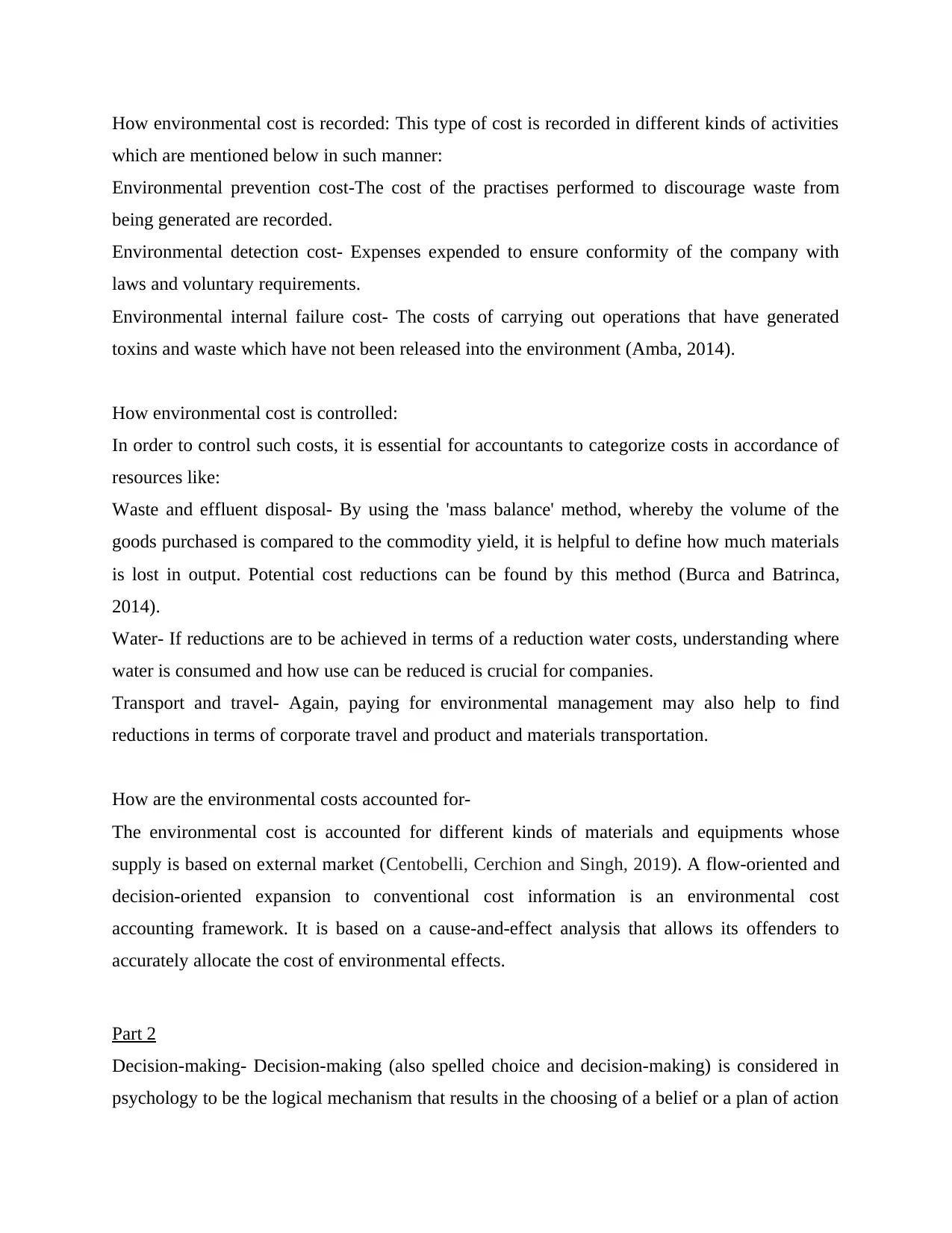
How environmental cost is recorded: This type of cost is recorded in different kinds of activities
which are mentioned below in such manner:
Environmental prevention cost-The cost of the practises performed to discourage waste from
being generated are recorded.
Environmental detection cost- Expenses expended to ensure conformity of the company with
laws and voluntary requirements.
Environmental internal failure cost- The costs of carrying out operations that have generated
toxins and waste which have not been released into the environment (Amba, 2014).
How environmental cost is controlled:
In order to control such costs, it is essential for accountants to categorize costs in accordance of
resources like:
Waste and effluent disposal- By using the 'mass balance' method, whereby the volume of the
goods purchased is compared to the commodity yield, it is helpful to define how much materials
is lost in output. Potential cost reductions can be found by this method (Burca and Batrinca,
2014).
Water- If reductions are to be achieved in terms of a reduction water costs, understanding where
water is consumed and how use can be reduced is crucial for companies.
Transport and travel- Again, paying for environmental management may also help to find
reductions in terms of corporate travel and product and materials transportation.
How are the environmental costs accounted for-
The environmental cost is accounted for different kinds of materials and equipments whose
supply is based on external market (Centobelli, Cerchion and Singh, 2019). A flow-oriented and
decision-oriented expansion to conventional cost information is an environmental cost
accounting framework. It is based on a cause-and-effect analysis that allows its offenders to
accurately allocate the cost of environmental effects.
Part 2
Decision-making- Decision-making (also spelled choice and decision-making) is considered in
psychology to be the logical mechanism that results in the choosing of a belief or a plan of action
which are mentioned below in such manner:
Environmental prevention cost-The cost of the practises performed to discourage waste from
being generated are recorded.
Environmental detection cost- Expenses expended to ensure conformity of the company with
laws and voluntary requirements.
Environmental internal failure cost- The costs of carrying out operations that have generated
toxins and waste which have not been released into the environment (Amba, 2014).
How environmental cost is controlled:
In order to control such costs, it is essential for accountants to categorize costs in accordance of
resources like:
Waste and effluent disposal- By using the 'mass balance' method, whereby the volume of the
goods purchased is compared to the commodity yield, it is helpful to define how much materials
is lost in output. Potential cost reductions can be found by this method (Burca and Batrinca,
2014).
Water- If reductions are to be achieved in terms of a reduction water costs, understanding where
water is consumed and how use can be reduced is crucial for companies.
Transport and travel- Again, paying for environmental management may also help to find
reductions in terms of corporate travel and product and materials transportation.
How are the environmental costs accounted for-
The environmental cost is accounted for different kinds of materials and equipments whose
supply is based on external market (Centobelli, Cerchion and Singh, 2019). A flow-oriented and
decision-oriented expansion to conventional cost information is an environmental cost
accounting framework. It is based on a cause-and-effect analysis that allows its offenders to
accurately allocate the cost of environmental effects.
Part 2
Decision-making- Decision-making (also spelled choice and decision-making) is considered in
psychology to be the logical mechanism that results in the choosing of a belief or a plan of action
⊘ This is a preview!⊘
Do you want full access?
Subscribe today to unlock all pages.

Trusted by 1+ million students worldwide
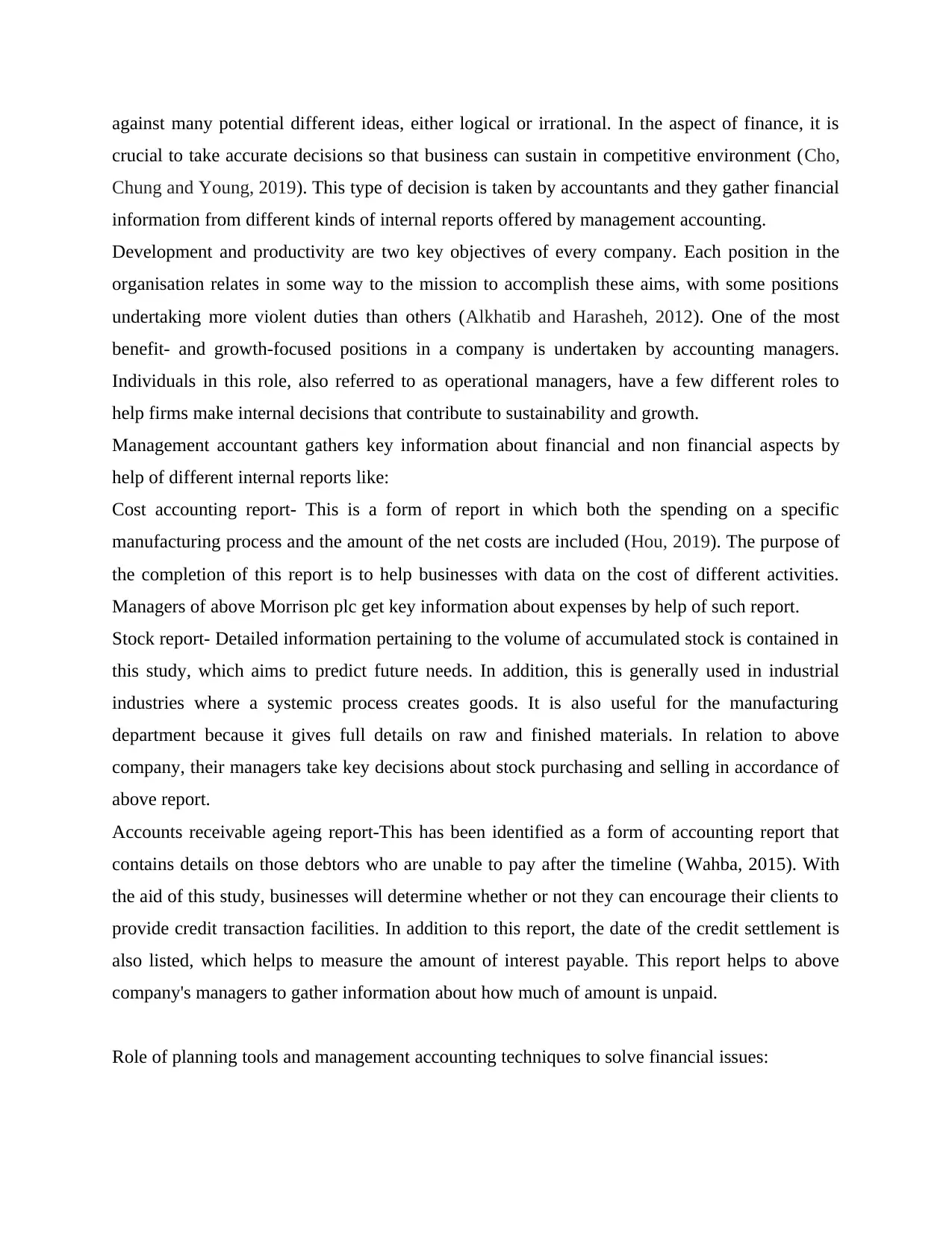
against many potential different ideas, either logical or irrational. In the aspect of finance, it is
crucial to take accurate decisions so that business can sustain in competitive environment (Cho,
Chung and Young, 2019). This type of decision is taken by accountants and they gather financial
information from different kinds of internal reports offered by management accounting.
Development and productivity are two key objectives of every company. Each position in the
organisation relates in some way to the mission to accomplish these aims, with some positions
undertaking more violent duties than others (Alkhatib and Harasheh, 2012). One of the most
benefit- and growth-focused positions in a company is undertaken by accounting managers.
Individuals in this role, also referred to as operational managers, have a few different roles to
help firms make internal decisions that contribute to sustainability and growth.
Management accountant gathers key information about financial and non financial aspects by
help of different internal reports like:
Cost accounting report- This is a form of report in which both the spending on a specific
manufacturing process and the amount of the net costs are included (Hou, 2019). The purpose of
the completion of this report is to help businesses with data on the cost of different activities.
Managers of above Morrison plc get key information about expenses by help of such report.
Stock report- Detailed information pertaining to the volume of accumulated stock is contained in
this study, which aims to predict future needs. In addition, this is generally used in industrial
industries where a systemic process creates goods. It is also useful for the manufacturing
department because it gives full details on raw and finished materials. In relation to above
company, their managers take key decisions about stock purchasing and selling in accordance of
above report.
Accounts receivable ageing report-This has been identified as a form of accounting report that
contains details on those debtors who are unable to pay after the timeline (Wahba, 2015). With
the aid of this study, businesses will determine whether or not they can encourage their clients to
provide credit transaction facilities. In addition to this report, the date of the credit settlement is
also listed, which helps to measure the amount of interest payable. This report helps to above
company's managers to gather information about how much of amount is unpaid.
Role of planning tools and management accounting techniques to solve financial issues:
crucial to take accurate decisions so that business can sustain in competitive environment (Cho,
Chung and Young, 2019). This type of decision is taken by accountants and they gather financial
information from different kinds of internal reports offered by management accounting.
Development and productivity are two key objectives of every company. Each position in the
organisation relates in some way to the mission to accomplish these aims, with some positions
undertaking more violent duties than others (Alkhatib and Harasheh, 2012). One of the most
benefit- and growth-focused positions in a company is undertaken by accounting managers.
Individuals in this role, also referred to as operational managers, have a few different roles to
help firms make internal decisions that contribute to sustainability and growth.
Management accountant gathers key information about financial and non financial aspects by
help of different internal reports like:
Cost accounting report- This is a form of report in which both the spending on a specific
manufacturing process and the amount of the net costs are included (Hou, 2019). The purpose of
the completion of this report is to help businesses with data on the cost of different activities.
Managers of above Morrison plc get key information about expenses by help of such report.
Stock report- Detailed information pertaining to the volume of accumulated stock is contained in
this study, which aims to predict future needs. In addition, this is generally used in industrial
industries where a systemic process creates goods. It is also useful for the manufacturing
department because it gives full details on raw and finished materials. In relation to above
company, their managers take key decisions about stock purchasing and selling in accordance of
above report.
Accounts receivable ageing report-This has been identified as a form of accounting report that
contains details on those debtors who are unable to pay after the timeline (Wahba, 2015). With
the aid of this study, businesses will determine whether or not they can encourage their clients to
provide credit transaction facilities. In addition to this report, the date of the credit settlement is
also listed, which helps to measure the amount of interest payable. This report helps to above
company's managers to gather information about how much of amount is unpaid.
Role of planning tools and management accounting techniques to solve financial issues:
Paraphrase This Document
Need a fresh take? Get an instant paraphrase of this document with our AI Paraphraser
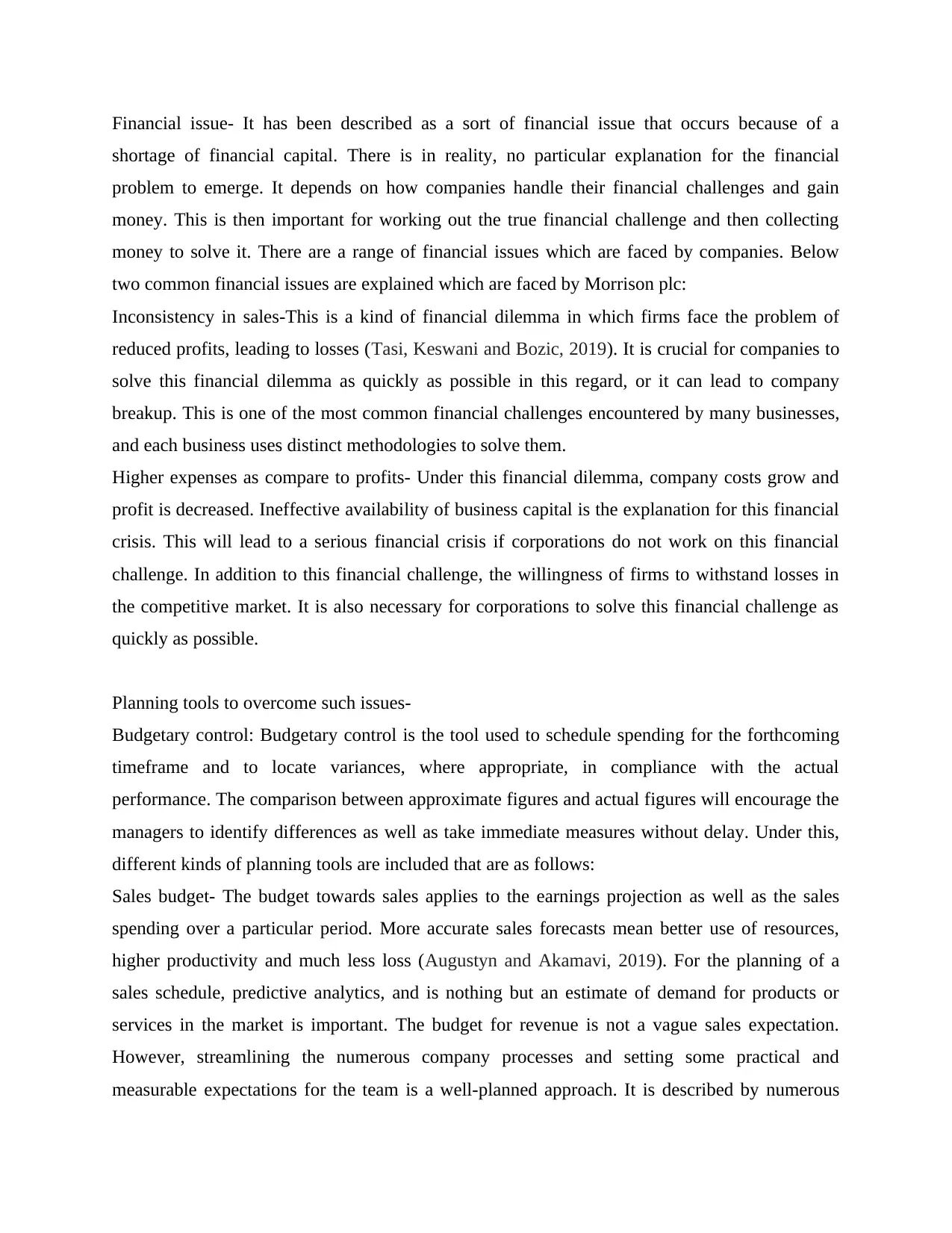
Financial issue- It has been described as a sort of financial issue that occurs because of a
shortage of financial capital. There is in reality, no particular explanation for the financial
problem to emerge. It depends on how companies handle their financial challenges and gain
money. This is then important for working out the true financial challenge and then collecting
money to solve it. There are a range of financial issues which are faced by companies. Below
two common financial issues are explained which are faced by Morrison plc:
Inconsistency in sales-This is a kind of financial dilemma in which firms face the problem of
reduced profits, leading to losses (Tasi, Keswani and Bozic, 2019). It is crucial for companies to
solve this financial dilemma as quickly as possible in this regard, or it can lead to company
breakup. This is one of the most common financial challenges encountered by many businesses,
and each business uses distinct methodologies to solve them.
Higher expenses as compare to profits- Under this financial dilemma, company costs grow and
profit is decreased. Ineffective availability of business capital is the explanation for this financial
crisis. This will lead to a serious financial crisis if corporations do not work on this financial
challenge. In addition to this financial challenge, the willingness of firms to withstand losses in
the competitive market. It is also necessary for corporations to solve this financial challenge as
quickly as possible.
Planning tools to overcome such issues-
Budgetary control: Budgetary control is the tool used to schedule spending for the forthcoming
timeframe and to locate variances, where appropriate, in compliance with the actual
performance. The comparison between approximate figures and actual figures will encourage the
managers to identify differences as well as take immediate measures without delay. Under this,
different kinds of planning tools are included that are as follows:
Sales budget- The budget towards sales applies to the earnings projection as well as the sales
spending over a particular period. More accurate sales forecasts mean better use of resources,
higher productivity and much less loss (Augustyn and Akamavi, 2019). For the planning of a
sales schedule, predictive analytics, and is nothing but an estimate of demand for products or
services in the market is important. The budget for revenue is not a vague sales expectation.
However, streamlining the numerous company processes and setting some practical and
measurable expectations for the team is a well-planned approach. It is described by numerous
shortage of financial capital. There is in reality, no particular explanation for the financial
problem to emerge. It depends on how companies handle their financial challenges and gain
money. This is then important for working out the true financial challenge and then collecting
money to solve it. There are a range of financial issues which are faced by companies. Below
two common financial issues are explained which are faced by Morrison plc:
Inconsistency in sales-This is a kind of financial dilemma in which firms face the problem of
reduced profits, leading to losses (Tasi, Keswani and Bozic, 2019). It is crucial for companies to
solve this financial dilemma as quickly as possible in this regard, or it can lead to company
breakup. This is one of the most common financial challenges encountered by many businesses,
and each business uses distinct methodologies to solve them.
Higher expenses as compare to profits- Under this financial dilemma, company costs grow and
profit is decreased. Ineffective availability of business capital is the explanation for this financial
crisis. This will lead to a serious financial crisis if corporations do not work on this financial
challenge. In addition to this financial challenge, the willingness of firms to withstand losses in
the competitive market. It is also necessary for corporations to solve this financial challenge as
quickly as possible.
Planning tools to overcome such issues-
Budgetary control: Budgetary control is the tool used to schedule spending for the forthcoming
timeframe and to locate variances, where appropriate, in compliance with the actual
performance. The comparison between approximate figures and actual figures will encourage the
managers to identify differences as well as take immediate measures without delay. Under this,
different kinds of planning tools are included that are as follows:
Sales budget- The budget towards sales applies to the earnings projection as well as the sales
spending over a particular period. More accurate sales forecasts mean better use of resources,
higher productivity and much less loss (Augustyn and Akamavi, 2019). For the planning of a
sales schedule, predictive analytics, and is nothing but an estimate of demand for products or
services in the market is important. The budget for revenue is not a vague sales expectation.
However, streamlining the numerous company processes and setting some practical and
measurable expectations for the team is a well-planned approach. It is described by numerous
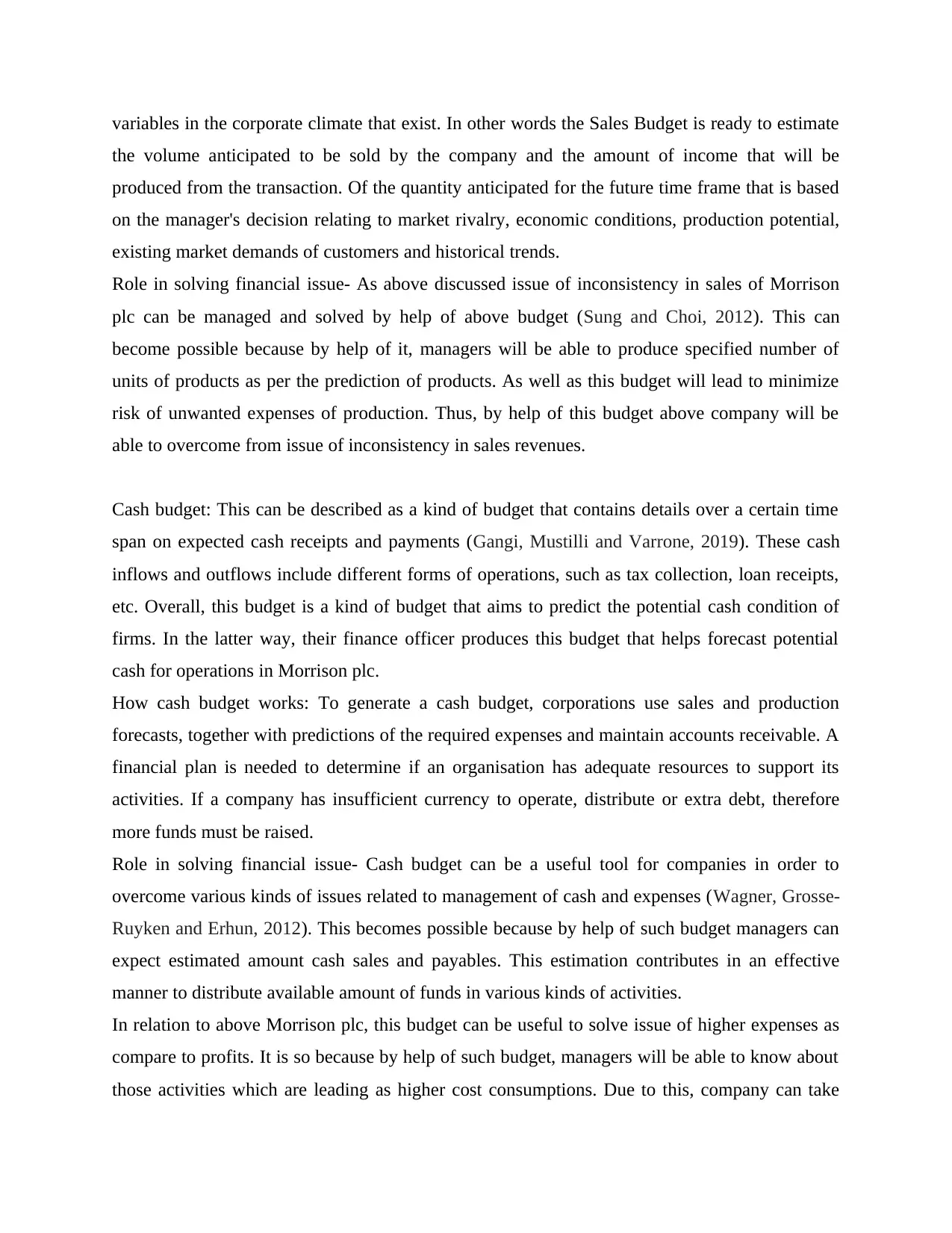
variables in the corporate climate that exist. In other words the Sales Budget is ready to estimate
the volume anticipated to be sold by the company and the amount of income that will be
produced from the transaction. Of the quantity anticipated for the future time frame that is based
on the manager's decision relating to market rivalry, economic conditions, production potential,
existing market demands of customers and historical trends.
Role in solving financial issue- As above discussed issue of inconsistency in sales of Morrison
plc can be managed and solved by help of above budget (Sung and Choi, 2012). This can
become possible because by help of it, managers will be able to produce specified number of
units of products as per the prediction of products. As well as this budget will lead to minimize
risk of unwanted expenses of production. Thus, by help of this budget above company will be
able to overcome from issue of inconsistency in sales revenues.
Cash budget: This can be described as a kind of budget that contains details over a certain time
span on expected cash receipts and payments (Gangi, Mustilli and Varrone, 2019). These cash
inflows and outflows include different forms of operations, such as tax collection, loan receipts,
etc. Overall, this budget is a kind of budget that aims to predict the potential cash condition of
firms. In the latter way, their finance officer produces this budget that helps forecast potential
cash for operations in Morrison plc.
How cash budget works: To generate a cash budget, corporations use sales and production
forecasts, together with predictions of the required expenses and maintain accounts receivable. A
financial plan is needed to determine if an organisation has adequate resources to support its
activities. If a company has insufficient currency to operate, distribute or extra debt, therefore
more funds must be raised.
Role in solving financial issue- Cash budget can be a useful tool for companies in order to
overcome various kinds of issues related to management of cash and expenses (Wagner, Grosse-
Ruyken and Erhun, 2012). This becomes possible because by help of such budget managers can
expect estimated amount cash sales and payables. This estimation contributes in an effective
manner to distribute available amount of funds in various kinds of activities.
In relation to above Morrison plc, this budget can be useful to solve issue of higher expenses as
compare to profits. It is so because by help of such budget, managers will be able to know about
those activities which are leading as higher cost consumptions. Due to this, company can take
the volume anticipated to be sold by the company and the amount of income that will be
produced from the transaction. Of the quantity anticipated for the future time frame that is based
on the manager's decision relating to market rivalry, economic conditions, production potential,
existing market demands of customers and historical trends.
Role in solving financial issue- As above discussed issue of inconsistency in sales of Morrison
plc can be managed and solved by help of above budget (Sung and Choi, 2012). This can
become possible because by help of it, managers will be able to produce specified number of
units of products as per the prediction of products. As well as this budget will lead to minimize
risk of unwanted expenses of production. Thus, by help of this budget above company will be
able to overcome from issue of inconsistency in sales revenues.
Cash budget: This can be described as a kind of budget that contains details over a certain time
span on expected cash receipts and payments (Gangi, Mustilli and Varrone, 2019). These cash
inflows and outflows include different forms of operations, such as tax collection, loan receipts,
etc. Overall, this budget is a kind of budget that aims to predict the potential cash condition of
firms. In the latter way, their finance officer produces this budget that helps forecast potential
cash for operations in Morrison plc.
How cash budget works: To generate a cash budget, corporations use sales and production
forecasts, together with predictions of the required expenses and maintain accounts receivable. A
financial plan is needed to determine if an organisation has adequate resources to support its
activities. If a company has insufficient currency to operate, distribute or extra debt, therefore
more funds must be raised.
Role in solving financial issue- Cash budget can be a useful tool for companies in order to
overcome various kinds of issues related to management of cash and expenses (Wagner, Grosse-
Ruyken and Erhun, 2012). This becomes possible because by help of such budget managers can
expect estimated amount cash sales and payables. This estimation contributes in an effective
manner to distribute available amount of funds in various kinds of activities.
In relation to above Morrison plc, this budget can be useful to solve issue of higher expenses as
compare to profits. It is so because by help of such budget, managers will be able to know about
those activities which are leading as higher cost consumptions. Due to this, company can take
⊘ This is a preview!⊘
Do you want full access?
Subscribe today to unlock all pages.

Trusted by 1+ million students worldwide
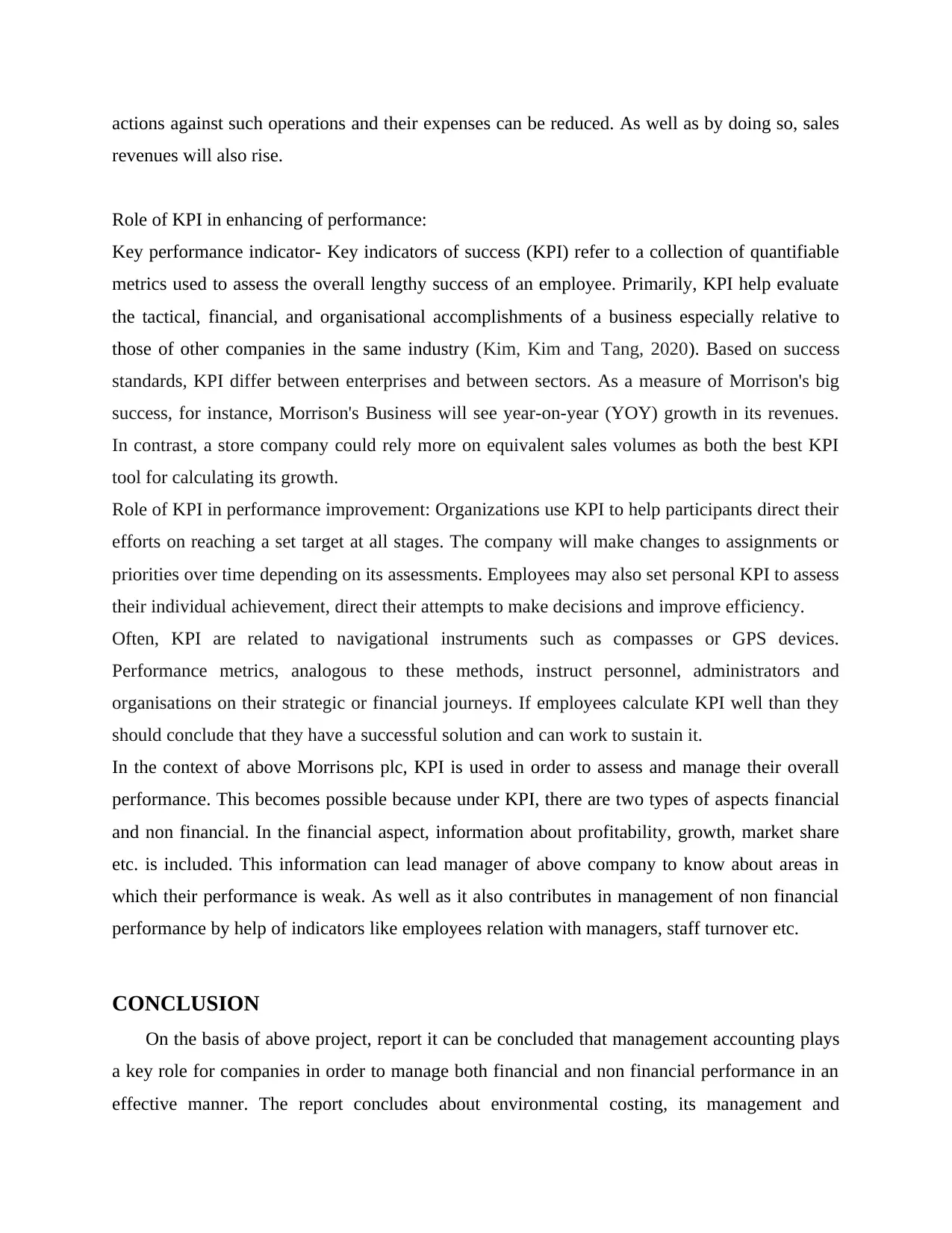
actions against such operations and their expenses can be reduced. As well as by doing so, sales
revenues will also rise.
Role of KPI in enhancing of performance:
Key performance indicator- Key indicators of success (KPI) refer to a collection of quantifiable
metrics used to assess the overall lengthy success of an employee. Primarily, KPI help evaluate
the tactical, financial, and organisational accomplishments of a business especially relative to
those of other companies in the same industry (Kim, Kim and Tang, 2020). Based on success
standards, KPI differ between enterprises and between sectors. As a measure of Morrison's big
success, for instance, Morrison's Business will see year-on-year (YOY) growth in its revenues.
In contrast, a store company could rely more on equivalent sales volumes as both the best KPI
tool for calculating its growth.
Role of KPI in performance improvement: Organizations use KPI to help participants direct their
efforts on reaching a set target at all stages. The company will make changes to assignments or
priorities over time depending on its assessments. Employees may also set personal KPI to assess
their individual achievement, direct their attempts to make decisions and improve efficiency.
Often, KPI are related to navigational instruments such as compasses or GPS devices.
Performance metrics, analogous to these methods, instruct personnel, administrators and
organisations on their strategic or financial journeys. If employees calculate KPI well than they
should conclude that they have a successful solution and can work to sustain it.
In the context of above Morrisons plc, KPI is used in order to assess and manage their overall
performance. This becomes possible because under KPI, there are two types of aspects financial
and non financial. In the financial aspect, information about profitability, growth, market share
etc. is included. This information can lead manager of above company to know about areas in
which their performance is weak. As well as it also contributes in management of non financial
performance by help of indicators like employees relation with managers, staff turnover etc.
CONCLUSION
On the basis of above project, report it can be concluded that management accounting plays
a key role for companies in order to manage both financial and non financial performance in an
effective manner. The report concludes about environmental costing, its management and
revenues will also rise.
Role of KPI in enhancing of performance:
Key performance indicator- Key indicators of success (KPI) refer to a collection of quantifiable
metrics used to assess the overall lengthy success of an employee. Primarily, KPI help evaluate
the tactical, financial, and organisational accomplishments of a business especially relative to
those of other companies in the same industry (Kim, Kim and Tang, 2020). Based on success
standards, KPI differ between enterprises and between sectors. As a measure of Morrison's big
success, for instance, Morrison's Business will see year-on-year (YOY) growth in its revenues.
In contrast, a store company could rely more on equivalent sales volumes as both the best KPI
tool for calculating its growth.
Role of KPI in performance improvement: Organizations use KPI to help participants direct their
efforts on reaching a set target at all stages. The company will make changes to assignments or
priorities over time depending on its assessments. Employees may also set personal KPI to assess
their individual achievement, direct their attempts to make decisions and improve efficiency.
Often, KPI are related to navigational instruments such as compasses or GPS devices.
Performance metrics, analogous to these methods, instruct personnel, administrators and
organisations on their strategic or financial journeys. If employees calculate KPI well than they
should conclude that they have a successful solution and can work to sustain it.
In the context of above Morrisons plc, KPI is used in order to assess and manage their overall
performance. This becomes possible because under KPI, there are two types of aspects financial
and non financial. In the financial aspect, information about profitability, growth, market share
etc. is included. This information can lead manager of above company to know about areas in
which their performance is weak. As well as it also contributes in management of non financial
performance by help of indicators like employees relation with managers, staff turnover etc.
CONCLUSION
On the basis of above project, report it can be concluded that management accounting plays
a key role for companies in order to manage both financial and non financial performance in an
effective manner. The report concludes about environmental costing, its management and
Paraphrase This Document
Need a fresh take? Get an instant paraphrase of this document with our AI Paraphraser

consequences due to ineffective management. The further part of report concludes about role of
planning tools in order to overcome from financial problem. Under the report, different kinds of
planning tools like sales budget, cash budget and many more. In addition to this, importance of
Key performance indicators is also explained in report including financial and non financial
indicators.
planning tools in order to overcome from financial problem. Under the report, different kinds of
planning tools like sales budget, cash budget and many more. In addition to this, importance of
Key performance indicators is also explained in report including financial and non financial
indicators.
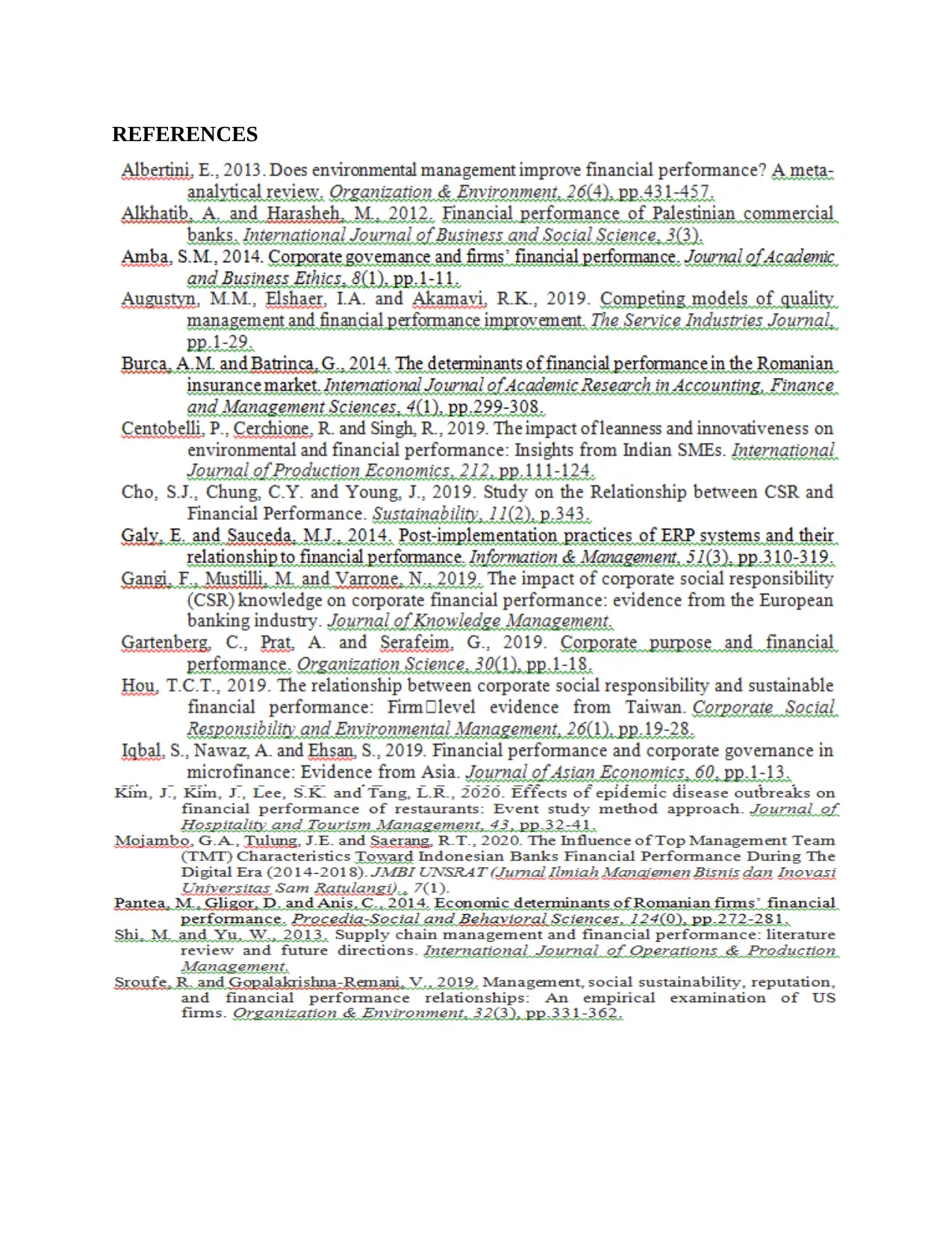
REFERENCES
⊘ This is a preview!⊘
Do you want full access?
Subscribe today to unlock all pages.

Trusted by 1+ million students worldwide
1 out of 13
Related Documents
Your All-in-One AI-Powered Toolkit for Academic Success.
+13062052269
info@desklib.com
Available 24*7 on WhatsApp / Email
![[object Object]](/_next/static/media/star-bottom.7253800d.svg)
Unlock your academic potential
Copyright © 2020–2025 A2Z Services. All Rights Reserved. Developed and managed by ZUCOL.





